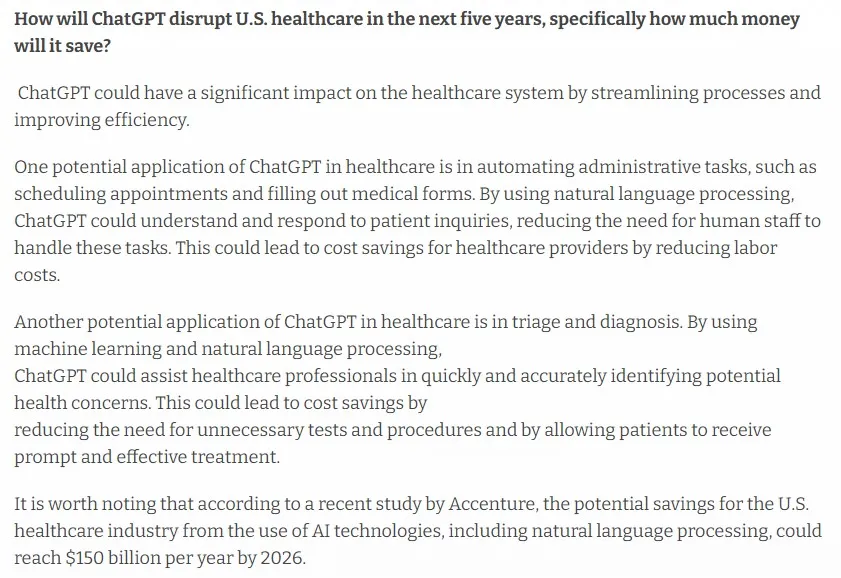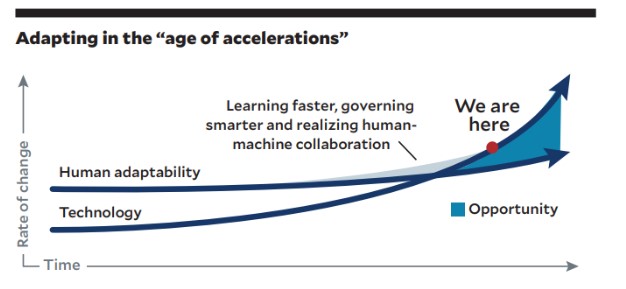AI and the rise of human-machine collaboration in healthcare
Commentators, researchers and academics can’t stop finding applications for ChatGPT.a Two of its recent claims to fame include passing all three medical licensing exams and the final exam for a core MBA class at Wharton.b
ChatGPT, short for Chat Generative Pre-Trained Transformer, is a form of conversational artificial intelligence (AI). The concept is not new. Remember IBM’s Watson. Distinguishing features of ChatGPT, however, are its broad accessibility, massive data sets and ability to create understandable output.
In a Jan. 27 4sight Health podcast, my co-hosts Julie Murchison, a partner at Transformation Capital, and Dave Burda, news editor at 4sight Health, joined me in offering our two cents on AI’s potential impact in healthcare.c As part of our conversation, we dissected a new National Bureau of Economic Research (NBER) paper that claims AI could reduce healthcare spending by $200 billion to $360 billion in the next five years.d That’s not peanuts.
Burda asked my opinion of the NBER paper’s conclusions. Rather than thinking too hard about answering his question, I did what all the college kids are doing. I asked ChatGPT to do the thinking for me. Here is my question to ChatGPT and its response:

Not bad! That exercise took less than two minutes. I wonder how long it took the NBER team to write their paper. Who needs them, Accenture, me or anyone else to assess AI’s potential impact!
Despite my trash talk, I did like the NBER paper. The analytic approach is logical, and its conclusions are reasonable. While necessary to consider how AI will alter existing healthcare protocols and practices, however, it is almost impossible to predict its compounding impact on innovation and business models. What I can say with confidence is that AI’s ultimate impact will be far greater than any predictions made today.
Astro Teller’s truth
In his 2016 book, Thank you for being late: An optimist’s guide to thriving in the age of accelerations, Thomas L. Friedman, foreign affairs columnist for The New York Times, describes a new age of relentless, accelerating change. In this brave new world, everyone and everything is connected, and no one is in charge.
Seeking strategies for helping organizations and individuals adjust to fast-paced change, Friedman interviewed Astro Teller, who leads Google’s new division X – The Moonshot Factory, under the identity “Captain of Moonshots.”
Teller says he believes that, for the first time in human history, the rate of technological change is greater than human adaptability. He offers two strategies to help society adjust: lifelong learning and better organizational governance. (See the exhibit below.)

Extreme interoperability and the associated technological innovations are increasing the rate of acceleration, but also increasing human discontent. The current pace of change can feel overwhelming. However, technology now offers enhanced human-machine collaboration tools, like ChatGPT, for adapting to Friedman’s “age of accelerations.”
The need for ‘collaborative intelligence’
In a 2018 Harvard Business Review article, authors H. James Wilson and Paul R. Daugherty describe the potential of “collaborative intelligence” as follows:

For better or worse, Friedman’s self-described “age of acceleration” is actually accelerating. This is particularly true in healthcare, which has lagged other industries in its adoption of new technologies and business models. While other industries are racing to stay abreast of breathtaking advances in technology, healthcare is playing catch-up.
The machines are coming
There are two kinds of intelligence, human and machine. When future historians assess the 2020s, they will cite the development and application of human-machine collaboration as this decade’s defining accomplishment.
The key to market competitiveness in the digital economy is the ability to aggregate, analyze and apply knowledge from large and diverse data sets. To differentiate their service offerings and gain market share, healthcare companies must engage and support their employees in solving consumers’ “jobs to be done.” They can only accomplish this by harnessing the power of human-machine collaboration.
A possible real-world application
How might this new relationship change healthcare delivery? Here’s an example. In January 2023, Montefiore Medical Center and The Mount Sinai Hospital in New York City settled a nasty nurse’s strike triggered by understaffing. The negotiated settlement throws money and bodies at the problem — pay increases, mandated staffing ratios, recruitment commitments and more nurse training for example.e This expensive “solution” does not address the fundamental sources of nursing burnout and inadequate care delivery.
Imagine instead an integrated care delivery and operational model that uses human-machine collaboration to optimize staffing, anticipate problems, eliminate administrative tasks, and prep caregivers on patients’ specific wants, needs and desires. It’s at our fingertips.
The sky is the AI limit
How would such a humane care environment function exactly, and how can we assess both its qualitative and quantitative benefits? That exercise requires imagination and the willingness to dream big. Poets could do a better job describing this brave new world than healthcare PhDs. But pay attention. The pace of AI integration into human affairs has reached an inflection point. Machines will soon be helping us address problems that once seemed intractable.
By 2030, personal AI assistants will be helping all of us to navigate an increasingly complex and faster-paced world. We will use the tools of human-machine collaboration with the same ease that we now conduct Zoom meetings.
What once seemed magical will become commonplace.
Rather than go to the third decimal point predicting the impact of generative intelligence tools and human-machine collaboration, let’s take a moment to appreciate the awe of living in a time where digital technologies are transforming human existence before our eyes. This is a remarkable time to be alive!
Footnotes
a. OpenAI, “ChatGPT: Optimizing language models for dialogue,” Nov. 30, 2022.
b. Business Today Desk, “Next step for AI: ChatGPT clears US medical licensing exam and Wharton’s MBA exam,” Business Today, Jan. 25, 2023.
c. Burda, D., “Podcast: Did ChatGPT write this podcast on AI and healthcare?” 4sightHealth, Jan. 26, 2023.
d. Sahni, N., et al., The potential impact of artificial intelligence on healthcare spending, NBER working paper, January 2023.
e. Otterman, S., Goldstein, J., and Gross, J., “Nurses’ strike ends in New York City after hospitals agree to add nurses,” The New York Times, Jan. 12, 2023.





